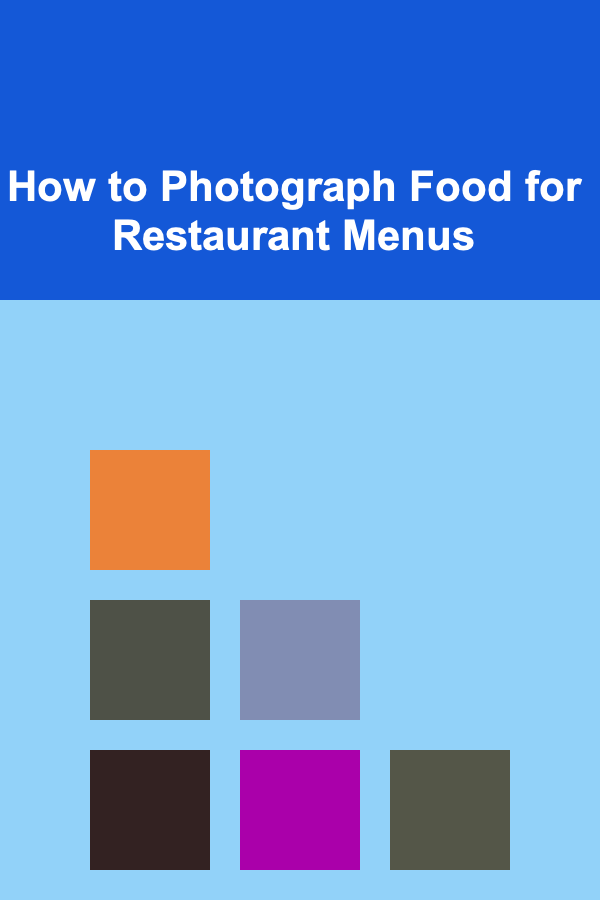
How to Photograph Food for Restaurant Menus
ebook include PDF & Audio bundle (Micro Guide)
$12.99$11.99
Limited Time Offer! Order within the next:

In today's competitive food industry, high-quality food photography is a crucial component of marketing and branding for restaurants. Food photography is not just about taking pictures of a meal; it's about creating an image that makes the food look so delicious that customers are compelled to visit the restaurant and order the dish. Properly executed food photography helps to convey the quality, ambiance, and essence of the restaurant, all while showcasing the food in the most appetizing way possible.
In this article, we will delve into the principles and techniques required to capture mouthwatering food photos for restaurant menus. From lighting and composition to styling and editing, this guide will help you understand how to master food photography and produce images that will attract customers.
The Importance of Food Photography in Restaurant Menus
Food photography serves as the visual representation of your restaurant's offerings. When potential customers look at your menu, they are likely to first notice the images accompanying each dish. Great food photography can have a significant impact on:
- Customer Attraction: Well-shot food photos are often the first thing that catches the attention of customers, especially in today's social media-driven world. Pictures of delicious food can draw in guests and get them excited to try your dishes.
- Brand Representation: The quality of food photography reflects the restaurant's overall standard. High-quality, professional photos indicate that the restaurant is serious about its offerings, while poor photos may suggest otherwise.
- Menu Appeal: Food images make it easier for customers to imagine themselves enjoying the dish. A visually appealing photo can evoke cravings, making it more likely that the customer will order the dish.
Setting the Scene: The Role of Menu Photography in Branding
A restaurant's menu photography plays a significant role in its branding. Each restaurant's style and personality should shine through in the photos. Whether you're a cozy family diner, a trendy gastro-pub, or an elegant fine dining establishment, the food images should reflect the atmosphere and target audience of your restaurant.
Professional food photography ensures that the dishes appear at their best and aligns with your restaurant's overall vibe. It builds an emotional connection with your audience, making them associate specific feelings---such as warmth, elegance, or excitement---with your restaurant.
Essential Equipment for Food Photography
Before you dive into the process of taking food photos, it's important to have the right tools. While a smartphone can capture decent food shots, investing in professional equipment can make a big difference. Here's a breakdown of essential tools for food photography:
Camera
While it's possible to capture decent images with a smartphone, a DSLR camera or a mirrorless camera offers much better control over the exposure, depth of field, and overall image quality. Look for a camera that offers manual control over settings such as aperture, shutter speed, and ISO. This will allow you to adjust the settings based on the lighting and subject.
- Recommended cameras: Canon EOS R, Nikon D850, or Sony Alpha 7R III.
Lenses
The lens you choose significantly affects how the image looks. For food photography, a 50mm lens (standard prime lens) or 100mm macro lens is ideal. A 50mm lens provides a natural perspective with a shallow depth of field, allowing you to blur the background and focus on the dish. On the other hand, a 100mm macro lens is excellent for detailed close-ups of textures and intricate elements of the food.
Tripod
A tripod helps keep your camera steady during the shoot, preventing blurry images, especially in lower light conditions. A tripod is essential for achieving consistent shots, particularly when photographing multiple dishes or shooting in a studio setup.
Lighting Equipment
Lighting is one of the most crucial aspects of food photography. Natural light is often preferred because it creates soft and flattering shadows. However, when shooting indoors or in environments without ample natural light, you will need additional light sources:
- Softboxes or diffusers: These can help soften harsh light and prevent unflattering shadows. Diffusing light is especially important for food photography because it highlights the food's texture and color without overexposing parts of the image.
- Reflectors: Reflectors bounce light back onto the subject, reducing harsh shadows and ensuring the food is evenly lit. They are also helpful in brightening up the dark areas of the dish.
Backdrops and Props
The background and props can enhance or distract from the dish you're photographing. Choose backgrounds and props that complement the food without stealing attention away from it. For instance, wooden tables work well for rustic or comfort foods, while a clean white background can suit elegant dishes.
- Backdrops: Choose textured surfaces like wood, marble, or fabric. They add depth and interest to the composition.
- Props: Items like cutlery, napkins, glasses, and condiments can help set the scene. Be sure not to overcrowd the frame---focus should remain on the dish.
Mastering Food Styling for Photography
Food styling is the art of presenting food in an aesthetically pleasing way. Just as important as the photography itself, styling is what makes the dish look irresistible and appetizing. Here are a few food styling tips:
Composition
Composition refers to how the food is arranged in the frame. Different compositions can evoke different emotions or focus attention on specific parts of the dish. Here are some common composition techniques:
- The Rule of Thirds: Divide the frame into a 3x3 grid. Position your dish or key elements of the dish along the grid lines or at their intersections to create balance and harmony.
- Leading Lines: Use natural lines, such as the edges of a plate or a swirl of sauce, to guide the viewer's eye toward the focal point of the image.
- Negative Space: Leave some areas of the frame empty to allow the food to stand out more. This helps prevent clutter and draws attention to the main subject.
Plating
How you plate the food is crucial for achieving a professional look. Here are some tips for plating food effectively:
- Use the right plate: Choose plates that complement the food and don't overwhelm it. Avoid plates that are too large or too small. White plates are classic and versatile, but colorful plates can work well for certain cuisines.
- Keep it neat: Avoid overcrowding the plate. Leave some space around the food to give the dish room to "breathe."
- Add garnishes: A few carefully placed garnishes---like fresh herbs, microgreens, or edible flowers---can make the dish look more polished and vibrant. However, be mindful not to overdo it, as too many garnishes can clutter the image.
Avoiding Common Food Styling Mistakes
- Avoid overcooking the food: Overcooked food looks unappetizing, so always aim to capture the food in its peak condition. This applies to both color and texture.
- Steer clear of artificial props: While it might be tempting to use fake food or "food tricks," such as glazing a steak with oil or using inedible props, these techniques can often look unnatural or even misleading.
- Consider texture: Texture is one of the most important elements in food photography. Ensure that textures such as crispy crusts, creamy sauces, and tender meat are captured clearly in the shot.
Lighting Techniques for Food Photography
Proper lighting is perhaps the most important factor in food photography. Without good lighting, even the best-styled food can appear unappetizing or unprofessional. Here are a few essential lighting techniques for photographing food:
Natural Lighting
Natural light, especially from a window, is often the preferred lighting source for food photography. It produces soft, flattering light that enhances the colors and textures of the food. Here are tips for working with natural light:
- Shoot near a window: Position your setup near a large window where the light is abundant but not too harsh. The best times for natural light are early in the morning or late afternoon when the sun is low in the sky.
- Diffuse the light: If the light is too harsh, use a sheer curtain or a diffuser to soften it. This will reduce hard shadows and create a more even light across the food.
- Use reflectors: A white reflector can bounce the natural light back onto the food, filling in any shadows and ensuring that the food is evenly lit.
Artificial Lighting
When shooting indoors or when natural light isn't available, you can use artificial lights such as softboxes or LED panels. Here are a few tips for working with artificial light:
- Avoid harsh lighting: Hard light creates harsh shadows and makes food appear unflattering. Instead, opt for soft, diffused lighting.
- Use multiple light sources: Position light sources on different sides of the food to create an evenly lit image. A light placed to the side or behind the food can create depth and texture.
- White balance: Ensure your white balance is set correctly to avoid warm or cool tones that may distort the colors of the food.
Post-Processing and Editing Food Photos
Once the food has been photographed, the next step is editing the images to make them look their best. Proper editing can enhance the colors, contrast, and overall appeal of the dish. Here are some tips for editing food photos:
Adjusting Exposure
Make sure the exposure is correct by adjusting the brightness, shadows, and highlights. Food photos should never look too dark or overexposed. Slightly increasing the exposure can help bring out the vibrancy in the colors, but be careful not to overdo it.
Enhancing Colors
Adjusting the saturation, vibrance, and contrast can make the colors pop without making the food look unnatural. Be cautious about over-saturating the image, as this can result in an overly processed look.
Sharpening the Image
Sharpen the image slightly to enhance the textures and details, such as the crispiness of fried food or the smoothness of a sauce. However, excessive sharpening can introduce noise, so it's important to apply it subtly.
Cropping and Straightening
Sometimes, a minor crop or straightening can improve the composition of a food photo. Make sure the food is positioned in the most flattering way and ensure that the image is aligned properly.
Conclusion
Photographing food for restaurant menus requires a combination of technical skills, creativity, and attention to detail. By mastering the basics of composition, lighting, and styling, you can create mouthwatering images that make customers eager to try your dishes. High-quality food photography is an investment in your restaurant's marketing and branding strategy. When done right, it not only showcases your food at its best but also communicates the essence and experience of your restaurant to your customers.
Reading More From Our Other Websites
- [Tiny Home Living Tip 101] Best Compact Appliances That Deliver Big Performance in Tiny Homes
- [Organization Tip 101] How to Organize Your Living Room for Movie Nights
- [Organization Tip 101] How to Make a Moving Playlist to Keep Spirits Up
- [Polymer Clay Modeling Tip 101] Best Ways to Simulate Water Droplets and Frost on Polymer Clay Miniatures
- [Home Rental Property 101] How to Find Pet‑Friendly Rentals: A Comprehensive Guide
- [Horseback Riding Tip 101] From Grooming to Girth: A Complete Checklist for Saddling a Horse Safely
- [Home Holiday Decoration 101] How to Decorate with Holiday Garland and Greenery
- [Personal Investment 101] Creating AI-Powered Apps for Passive Income with Deep Learning
- [Home Soundproofing 101] How to Reduce Noise in a Home Theater with Simple Soundproofing Tips
- [Personal Care Tips 101] How to Create a Lip Care Routine for Soft, Smooth Lips

Easy and Effective Tips for Reducing Water Usage in Your Daily Life
Read More
How to Create a Digital Gallery for Kids' Art Projects
Read More
How to DIY Holiday Garlands to Brighten Your Home
Read More
How to Use Binders for Organizing Recipes and Meal Ideas
Read More
Turning Deep Learning Skills into Passive Income through Freelance Work
Read More
10 Tips for Managing IoT Device Deployment as an Architect
Read MoreOther Products

Easy and Effective Tips for Reducing Water Usage in Your Daily Life
Read More
How to Create a Digital Gallery for Kids' Art Projects
Read More
How to DIY Holiday Garlands to Brighten Your Home
Read More
How to Use Binders for Organizing Recipes and Meal Ideas
Read More
Turning Deep Learning Skills into Passive Income through Freelance Work
Read More